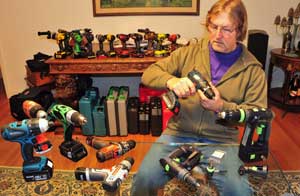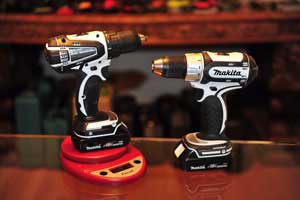Like most red-blooded 21st century woodworkers, I have a thing for power tools. Especially high performance portable power tools. Wrapping my hands around the latest, most powerful reciprocating saw, D-handled router, orbital sander, impact driver, etc., makes me almost as happy as if I’d just taken a pavement-scorching ride in a new Ferrari. The precise feel of the tool’s trigger, the jolt up my arm as the motor roars up to speed; it just gets my blood pumping.
So you can imagine how high my blood pressure is climbing, now that I’m sitting here at a table that’s literally overflowing with nearly two dozen of the latest and greatest cordless drill/drivers in the world. Models from Bosch, DeWalt, Festool, Hitachi, Makita, Milwaukee, Panasonic, Porter-Cable and more are all here for evaluation, as part of an article I’m writing for Woodworker’s Journal on the current state of drill/driver science and art. I’m relishing every screw-driving and hole-drilling moment as I put each tool through its paces, trying out every feature and usable setting. Later, I’ll have a chance to talk with some of the product engineers, designers, and battery chemists that are responsible for making these tools as good as they are.
When I stood back and looked at these tools as a group, the first thing I noticed is that all these tools are powered by lithium-ion batteries. Not that long ago, Li-ion packs were a brand-new technology that was expensive and not that dependable. The manufacturers have clearly dialed in these packs and brought the prices down to where even budget DIY models sport lithium packs.
I also noticed how much smaller these drills are than models of the same voltage were not that many years ago. In fact, I pulled out an older white Makita 18-volt compact drill (model LXFD01CW, one of my favorite “everyday” tools) and compared it to a brand-new one. There are a few cosmetic changes — newly styled grip rubber, motor air vents, sliding gear change lever, etc. But the biggest difference is that the new Makita compact has a shorter body length (thanks to a new chuck and clutch ring) and is almost three ounces lighter, even though the two drills use exactly the same small lithium-ion battery pack.
 When it comes to power, many of these new drill/drivers are nothing short of amazing. I picked up Porter-Cable’s brand-new PCL180CD, which is so compact, it practically looks like a downsized model made for folks with small hands. But when I triggered the tool on and tried to hang onto the chuck to keep it from spinning at the highest clutch setting (with leather work gloves on, of course), I was floored: I simply couldn’t do it! This tool, as well as compact models by Ridgid, Bosch, Milwaukee and others, just seem to pump out unreal amounts of torque, even when switched to a higher speed! When you look at the diminutive size of these tools’ slide-on battery packs, this kind of power output just doesn’t seem possible.
When it comes to power, many of these new drill/drivers are nothing short of amazing. I picked up Porter-Cable’s brand-new PCL180CD, which is so compact, it practically looks like a downsized model made for folks with small hands. But when I triggered the tool on and tried to hang onto the chuck to keep it from spinning at the highest clutch setting (with leather work gloves on, of course), I was floored: I simply couldn’t do it! This tool, as well as compact models by Ridgid, Bosch, Milwaukee and others, just seem to pump out unreal amounts of torque, even when switched to a higher speed! When you look at the diminutive size of these tools’ slide-on battery packs, this kind of power output just doesn’t seem possible.
There’s lots more I’d like to tell you about these tools, but I’m afraid you’ll have to read my article, which is slated to appear in the upcoming January/February 2012 issue. Until then, happy drilling and driving!
Sandor Nagyszalanczy
Contributing Editor





